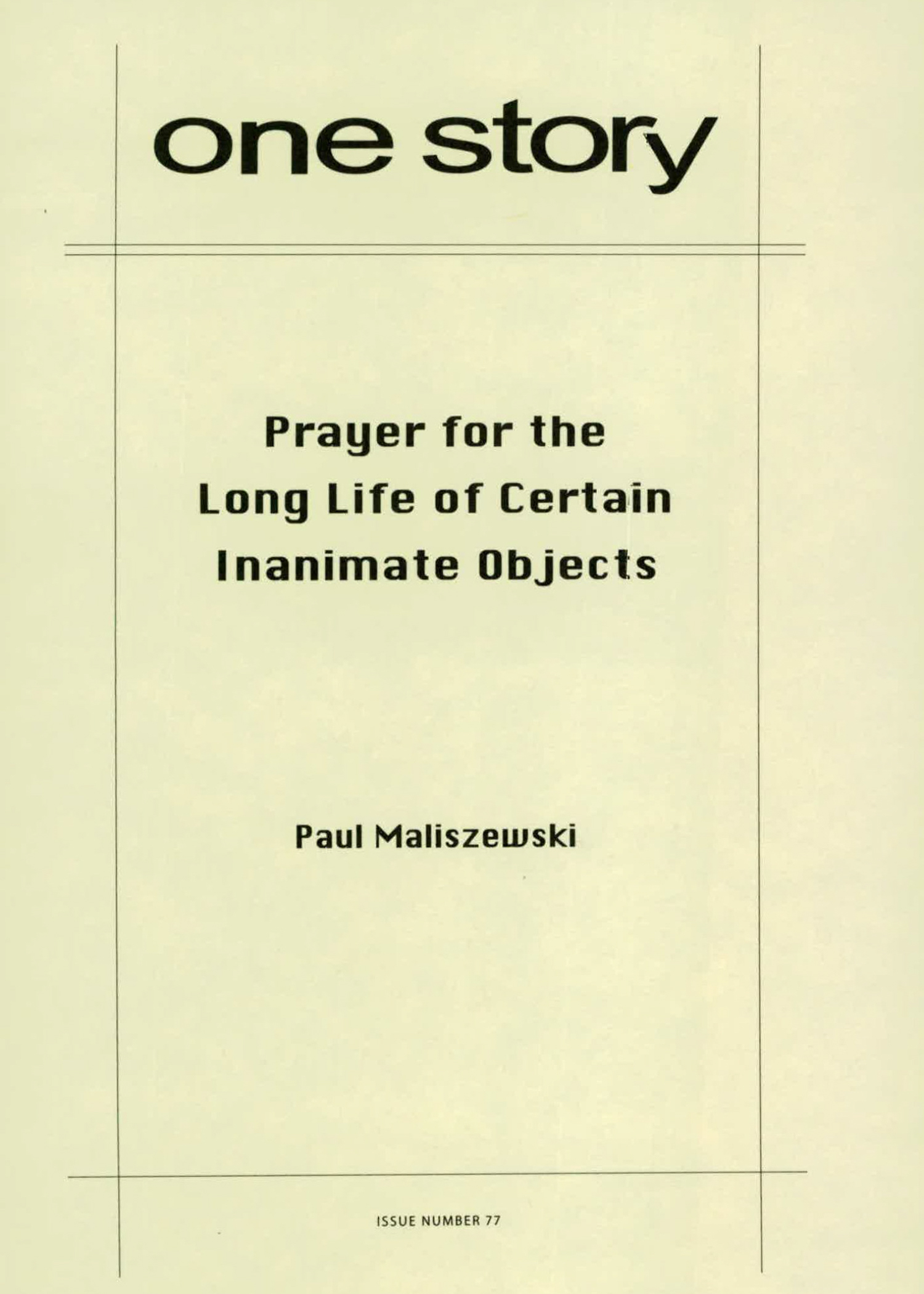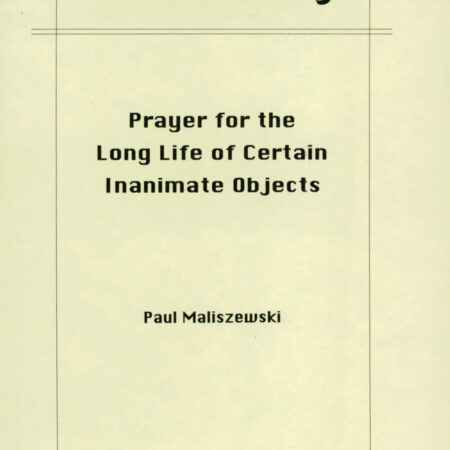
Prayer for the Long Life of Certain Inanimate Objects
$2.50
44 in stock
Excerpt
When he was a baby, the new robot crouched on a wooden platform beside his crib, watching over and caring for him. The robot also completed various chores. For example, the robot unfolded or folded his blanket. And the robot fetched things. In the kitchen, the robot stood at the counter, heating bottles on the stove and warming up baby food. When he needed changing, the robot pinched the ends of the diaper together while his mother or father fastened and secured the safety pins.
Later came a series of family photos in which he stood between the robot and his father. In these photos, his father had an arm around his mother’s waist and a hand on top of his head, and through all of this posing, while they kept their smiles fixed for the camera and listened for the sound of the shutter, he had to hold hands with the new robot. His father told him to hold hands with the robot. His mother agreed, saying she thought it would “look cute.” You’re almost as tall as the robot, she pointed out. The robot squeezed his hand slightly. It didn’t hurt. It just felt like holding hands with a robot.
Paul Maliszewski
Paul Maliszewski’s stories have been published in The Paris Review, Harper’s, and the Pushcart Prize anthologies, among other places. He lives in Washington, D.C., and is at work on a collection of stories.
Q&A by Hannah Tinti
- HT: Where did the idea for this story come from?
- PM: One day, for some reason, I imagined a family photograph with a robot in it. Father, mother, and son were posing with their new robot. That’s how the story started. I didn’t know what it was going to be about or even who the family was. I just knew that the kid didn’t like being in the picture with the robot. Taking family photographs is excruciating enough. I followed the family and their robot through a few scenes. It wasn’t much of a story. It was a short sketch really, just glimpses of the family, snapshots of them at different ages. The joke of it—because originally it was supposed to be funny—was that here’s this family of the near future, living with their robot, but look how they have to deal with all the usual family stuff. Quite an idea. I titled the story, “The New Robot.” I should have called it The Jetsons. It was about 1,000 words long and plagued by sit-com timing. Situations were set up and then immediately deflated. I put it aside for years.
- HT: What was the most challenging aspect of writing this story?
- PM: The family was what interested me when I went back to the story, especially the father and his sons. So the main challenge was giving the family real depth of character, the whole family. I like characters who are thoughtful and articulate, people who have dreams and pet theories, and I like narrators who, in the course of telling a story, give us a sense of the way those characters think, the sort of words they use, their habits of mind. When this story turns to the mother, for instance, the narrator changes, just slightly, and you get to peek into the mother’s consciousness and hear her language. It’s not drastically different. It’s as if you were sitting in a blue room and the color of the walls changed, becoming two shades more intense, just enough to notice.
- HT: Do you have any personal experience with robots?
- PM: I was about to say no, none, sorry, but then I remembered that my brother used to work at the Robotics Institute at Carnegie Mellon. They designed the Mars rovers and built Dante, that robot that explored the insides of volcanoes. My brother worked on the software side, programming the user interfaces to make the robots easier for someone to operate. All that must have been somewhere at the back of my mind, but I don’t recall drawing on it specifically. And I’m sure what I wrote about building robots is woefully misinformed.
- HT: The only person with a name in this piece is Alan Bynner. Why did you decide not to name any of the members of the family?
- PM: I didn’t want the family’s namelessness to suggest that they are in any way universal, an Every Family. They are a very specific family, and I think of them as individuals. I guess I just don’t think names are that important. Or all that necessary in a story. When I’m trying to create a character like the father, I don’t find it helpful to think of him as Peter the Father, or Tim or Hans or whatever. In fact, sometimes I find that once I’ve named characters, I get lazy about trying to realize them fully. I want to find other, more particular ways to make them seem real. I’d much rather give a character a great dream or an odd thought or a telltale habit than the perfect name. Bynner has a name because it’s tricky, logistically, to have many unnamed characters in a scene. The air gets pretty thick with pronouns. Although I have written a story in which there are two couples, four people, and none of them has a name. I just didn’t want to keep calling Bynner the friend, the friend, the father’s friend.
- HT: The description of the two brothers trapped inside their father’s robot is haunting. Do you think this is the emotional center of the story? And if not, what is?
- PM: I hadn’t thought of it that way. I’m afraid I’d be really bad at putting my finger on the exact emotional center of stories. But yes, the scene’s pretty key. It’s a memory that bothers the older brother, and it’s a story he himself gets to tell, taking over for the narrator. It’s one of those things that has stuck with him. Everyone has those memories that just keep coming up, over and over, at odd times, often apropos of nothing that’s just happened. They’re like reminders from the past. I don’t know what they mean, necessarily. Sometimes they seem only to convey a constant refrain to remember, remember, remember.
- HT: Can you tell us a little about the title?
- PM: I’ve been working on a collection of these prayer stories and have about twenty-four now, with a handful more to write before I can say I’m done. All the stories are titled “Prayer for...” or “Prayer against...” Prayer books I’ve looked at, particularly eighteenth-century ones, have these wonderfully baroque and exacting titles. Every prayer addresses a precise set of circumstances. It’s like they’re spells for certain problems, or medicines for particular bodily complaints. As for the title of this story, I hope it will speak for itself by the end. My basic gloss, improvised here, after the writing is through, is that inanimate objects, these things we surround ourselves with, can take on such exaggerated significance. And more often than not, that significance is completely misplaced. We should be looking at people, facing them, talking to them, dealing with them, but instead we get tangled up in their things, in the stuff we share or fight over. So much of life plays out in a maddeningly indirect way, on a secondary and vaguely symbolic level. In this story, the brothers turn away from their father and wonder instead about his robots. They deal with him that way, through the robots. The animate world perplexes them, so they get embroiled in the inanimate one. At the end, they try to take the robot apart. But at that point they’re just playing with symbols. Sometimes though that symbolic level, however indirect and secondary it may be, is simply as close as we can ever come to facing our lives. It’s like how you can’t stare directly at the sun. So instead you do the next best thing: you study the small, fuzzy image it casts through a pinhole onto a piece of paper. Maybe we should be glad for symbols and inanimate objects. They’re useful props. They’re necessary.
- HT: How long did it take you to complete this story?
- PM: The computer says I started that early sketch on January 1, 2001, at 4 in the afternoon. God knows what possessed me to do that, on New Year’s Day. Next thing you know, I finished going over the proofs on June 21, 2006. What can I say? I worked on this story over a long period of time, in short, determined bursts punctuated with countless awkward lulls and many embarrassing stretches of inactivity.
- HT: What is the best bit of advice about writing you have ever received?
- PM: My teacher Michael Martone says—and I will quote him—“You can never have too much peripheral detail or too little on the color of a character’s eyes.” Along similar lines, he once formulated the theory of neat stuff, which holds that not every single thing in a story has to contribute to some airtight and flawless scheme. Some things, Michael says, are just neat.
- HT: What are you working on now?
- PM: Besides these prayer stories, I have a novel underway, about a character who writes letters to the President about his life, his family, and work. And I’m trying this summer to wrap up a collection of essays about the varieties of faking, except that every time I turn around there’s yet another instance of fakery. Finally, because my attention is not subdivided enough, my friend Steve Featherstone and I are working on a book about Joseph Mitchell.
